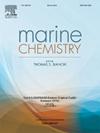Drivers of dissolved organic matter transport in the Guadalquivir estuary (SW, Spain)
IF 2.5
3区 地球科学
Q2 CHEMISTRY, MULTIDISCIPLINARY
引用次数: 0
Abstract
The Guadalquivir Estuary is the largest in the southwest Iberian Peninsula and is influenced by various anthropic activities, such as damming and rice farming, which regulate river flow and provide lateral inputs to the system. Despite its role as a major source of freshwater and dissolved organic matter (DOM) to the Gulf of Cadiz, there has been limited research on the seasonal distribution of DOM and dissolved organic carbon (DOC) export. This study chemically characterizes DOM using its optical properties along the salinity gradient and during tidal sampling cycles conducted from 2018 to 2022, improving the understanding of DOM dynamics in the estuary. Results show that the DOM in the estuary is predominantly allochthonous, with humic-like components accounting for 85.8 ± 5.8 % of fluorescent DOM (FDOM), while protein-like components, associated with autochthonous processes, account for only 14.2 ± 5.9 %. Mixing and biogeochemical reactivity are the main processes controlling DOM distribution, with mixing being the most significant. Lateral inputs from marshes and rice crops play an important role, particularly in the intermediate zone. Autochthonous DOM is more prominent during the dry season, especially in Summer. The estuary exports 5.8 g C m−2 yr−1 of DOC, along with substantial amounts of humic-like and protein-like FDOM, especially during extreme rainfall events that increase river flow, and therefore, discharge. DOC transport from the Guadalquivir Estuary is low if we consider the dimensions of its watershed area, highlighting the impact of damming on DOC transport.

瓜达尔基维尔河口(西班牙西南部)溶解有机质迁移的驱动因素
瓜达尔基维尔河口是伊比利亚半岛西南部最大的河口,受到各种人为活动的影响,如筑坝和种植水稻,这些活动调节河流流量并为该系统提供横向输入。尽管它是加的斯湾淡水和溶解有机物质(DOM)的主要来源,但对DOM和溶解有机碳(DOC)出口的季节性分布研究有限。本研究利用DOM在盐度梯度和2018 - 2022年潮汐采样周期中的光学特性对其进行化学表征,提高了对河口DOM动态的理解。结果表明,河口DOM以异源性为主,腐殖质样成分占荧光DOM (FDOM)的85.8±5.8%,而与本地过程相关的蛋白样成分仅占14.2±5.9%。混合和生物地球化学反应是控制DOM分布的主要过程,其中混合作用最为显著。来自沼泽和水稻作物的横向投入发挥了重要作用,特别是在中间地带。原生DOM在旱季尤其在夏季更为突出。河口输出5.8 g C m−2 yr−1的DOC,以及大量腐殖质样和蛋白质样FDOM,特别是在极端降雨事件期间,增加了河流流量,从而增加了流量。如果考虑到瓜达尔基维尔河口流域面积的大小,从该河口的DOC运输量很低,这突出了筑坝对DOC运输的影响。
本文章由计算机程序翻译,如有差异,请以英文原文为准。
求助全文
约1分钟内获得全文
求助全文
来源期刊

Marine Chemistry
化学-海洋学
CiteScore
6.00
自引率
3.30%
发文量
70
审稿时长
4.5 months
期刊介绍:
Marine Chemistry is an international medium for the publication of original studies and occasional reviews in the field of chemistry in the marine environment, with emphasis on the dynamic approach. The journal endeavours to cover all aspects, from chemical processes to theoretical and experimental work, and, by providing a central channel of communication, to speed the flow of information in this relatively new and rapidly expanding discipline.
 求助内容:
求助内容: 应助结果提醒方式:
应助结果提醒方式:


